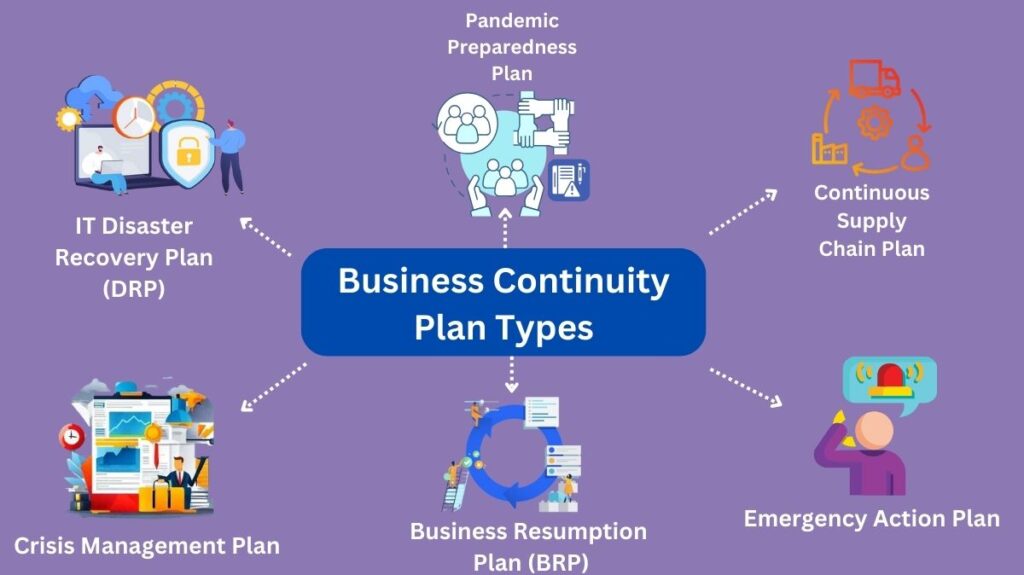Business Continuity Plan Types

IT Disaster Recovery Plan (DRP)
An IT disaster recovery strategy aims to restore IT systems, networks, and data after a cyber invasion, equipment failure, or data leak. Procedures for data backup, system renewal, and downtime reduction are outlined in order to guarantee the continuous survival of digital processes.
Crisis Management Plan
The Crisis Management Plan delineates the protocols for handling and reacting to crises that may endanger the organization’s standing, operational capacity, or financial stability. Protocols for evaluating risks, sending out emergency response teams, arranging correspondence with pertinent parties, and putting crisis communication plans into action are all included.
Pandemic Preparedness Plan
Pandemics and infectious disease outbreaks are covered by the plan. It must maintain core operations, allow work-from-home options to avoid interruptions, and protect workers’ health and safety.
Business Resumption Plan (BRP)
A business restart plan’s primary objective is to get the company back to normal after a disruption or calamity. It lays out steps for determining damages, setting priorities for recovery strategies, and implementing plans to restore vital institutions, operations, and resources.
Continuous Supply Chain Plan
The supply chain continuity strategy covers unexpected supplier defaults, delivery delays, and logistical issues. It covers methods for distributing suppliers, developing backup sourcing choices, and putting backup plans into action to guarantee ongoing delivery of goods or services.
Emergency Action Plan
The emergency plan covers fires, natural disasters, and industrial accidents. It includes building evacuation, first aid, and emergency services to protect employees and stakeholders.
Implementing Business Continuity Plan
Create a Structure
Assign a group or a Business Continuity Plan in charge of carrying out and maintaining the plan. Set communication channels, roles, and responsibilities, and ensure BCP chores are done correctly.
Conduct risk assessment and BIA
Look for company-impacting risks and hazards. Examples include natural calamities, computer hacks, and supply chain interruptions. After assessing its likelihood and severity, prioritise threats based on their potential impact on critical company processes.
Techniques for Forge Recovery
Create plans and safeguards to reduce the hazards that have been identified and ensure that vital business operations continue to run smoothly. Setting up backup systems, replication protocols, alternate workspaces, or forming alliances with suppliers and other stakeholders could all be part of this.
Create the BCP Report
Write the Business Continuity Plan report in an easy-to-read and understandable manner, including contact details, instructions, processes, and revival tactics. The plan needs to be understandable, succinct, and available to everyone involved.
Communicate and Train
Distribute the BCP to all staff members, interested parties, and relevant departments in the organisation. Plan training sessions and inform everyone of their roles and what to do in case of an emergency or crisis. To foster an environment that is preparedness-focused, promote candid communication and open behaviour.
Test and Exercise
To ascertain the BCP’s effectiveness and identify any flaws or possible areas for improvement, test and practise it often. Do drills, simulations, or tabletop exercises to simulate different emergencies and evaluate the organization’s response. Make a note of the things you’ve learnt and modify the plan as needed.
Stay Current and Adapt
The Business Continuity Plan (BCP) should be evaluated and modified regularly to reflect corporate structure, technology, and regulatory changes. Frequent risk assessments and Business Impact Analyses (BIAs) help identify new risks and adjust the plan.
Track and Maintain
Maintain a close eye on critical data, signals, and performance objectives to make sure the BCP continues to be applicable and effective throughout time. Put plans in place for continuing observation, cooperation, and evaluation to deal with problems or modifications as they appear.
Business Continuity Impact Analysis
Business continuity impact study examines how disruptive events may effect operations. Prioritise and identify key business processes, tasks, and resources and analyse their impact from operational failures, cyberattacks, and natural catastrophes. Business continuity impact evaluations help companies understand disruptions’ financial, operational, reputational, and legal effects. This helps firms reduce downtime, develop effective risk-management strategies, and operate efficiently under difficult conditions. An essential part of comprehensive continuity planning is this study. During a crisis, it enables organisations to concentrate their resources and efforts on safeguarding their most important assets and continuing essential operations.
Importance of a Business continuity plan
Risk Avoidance
Plans for business continuity can spot any risks and weaknesses that might disrupt regular operations. By identifying these risks early on, organisations can lessen the probability and impact of disruptions.
Sustaining Activities
Business continuity plans keep vital processes operating during pandemics, cyberattacks, and natural disasters.This ongoing endeavour lowers downtime, protects income, and improves customer happiness.
Preserving Credibility
Using business continuity strategies to react to crises promptly and efficiently can help an organisation preserve its reputation. Companies are more likely to win over stakeholders, partners, and customers if they demonstrate resiliency and preparation during difficult times.
Legal and Regulatory Adherence
Many industries must create and implement business continuity strategies due to legal and regulatory requirements. By following these rules, organisations can avoid legal issues and penalties.
Stability of Finance
Disruptions at work can lead to significant financial losses. By helping businesses recover from interruptions more quickly and efficiently, business continuity plans can lower these expenses while safeguarding their bottom line.
Safety and Welfare of Employees
Continuity plans ensure that representatives are comfortable and safe during emergencies. Organisations may boost employee morale and foster resilience by demonstrating concern for their well-being and provide clear instructions on what to do in emergency situations.
Management of the Supply Chain
Continuity plans often involve systems for tracking disruptions in the inventory network. By establishing communication routes, creating crisis plans, and finding alternative suppliers, associations can mitigate the effects of inventory network outages on their operations.
Flexible and resilient organisations
BCPs promote organisational adaptability and resilience. By regularly reviewing and updating their plans in response to changing risks and situations, organisations can improve their capacity to anticipate and handle future challenges, ensuring their long-term survival and success.
Read more on Business Continuity Plan Advantages And Disadvantages
